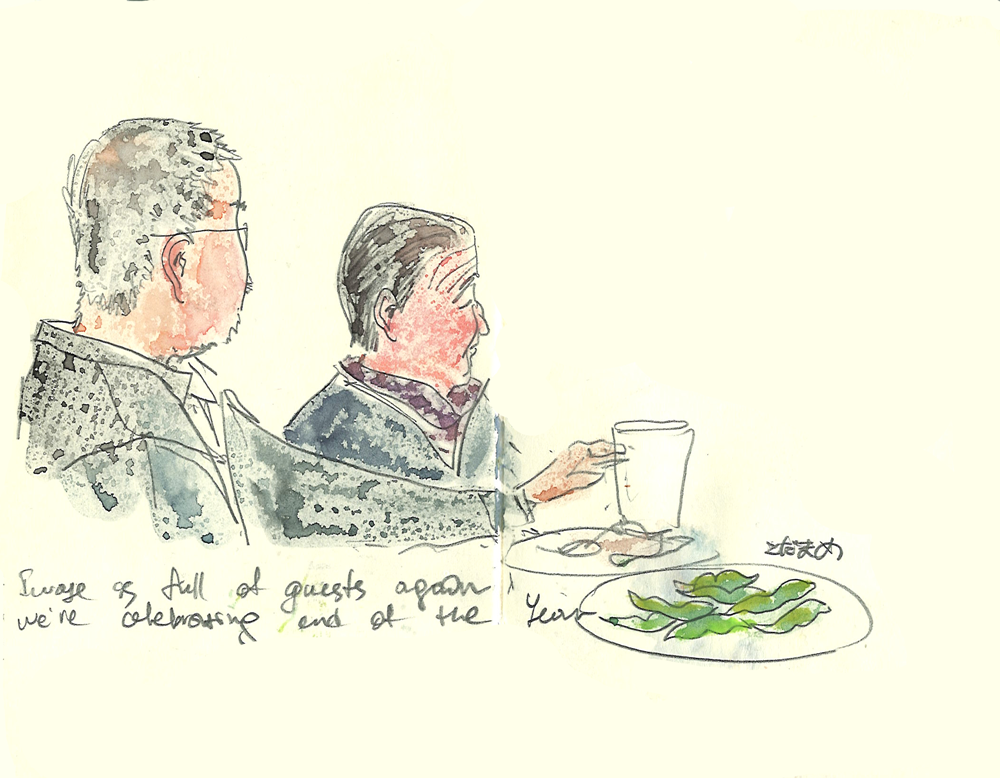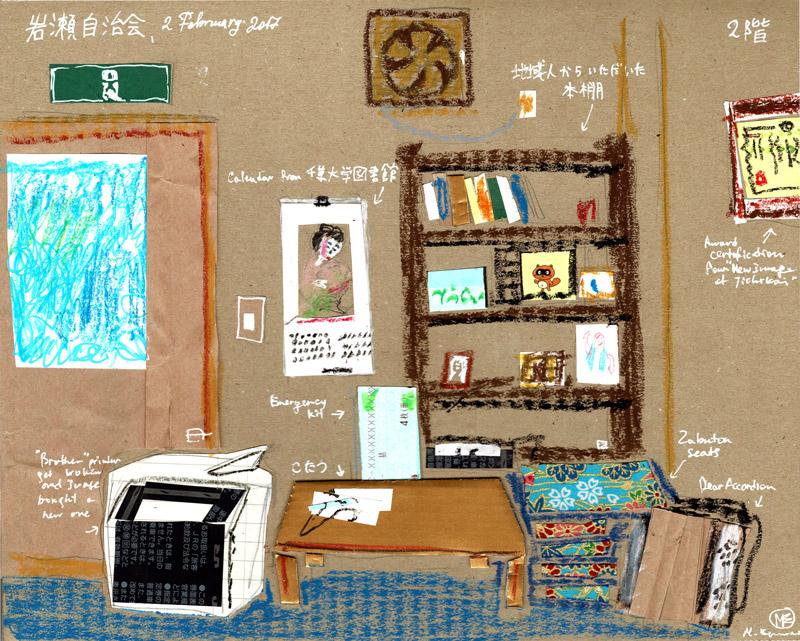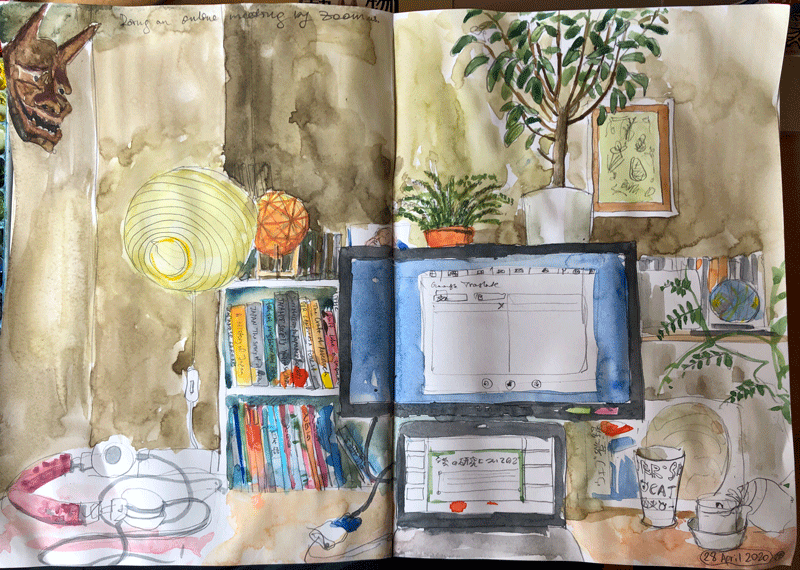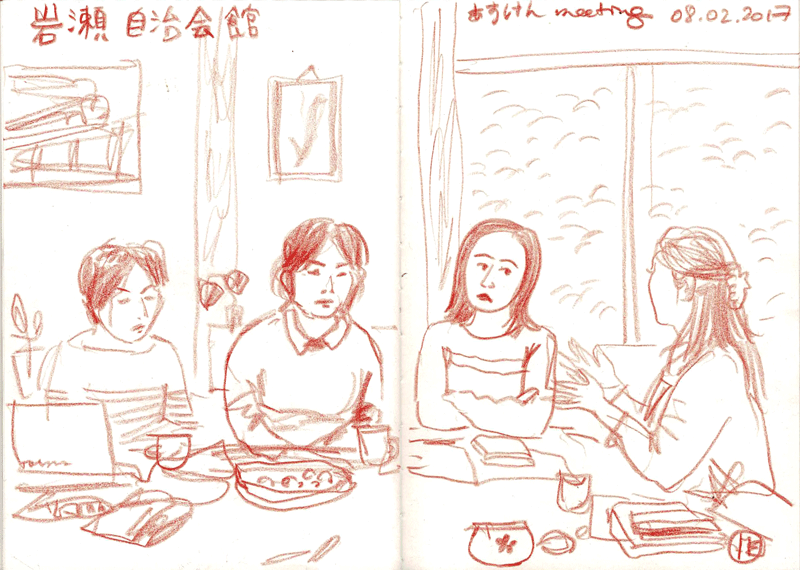Mariia Ermilova
Mariia is a multidisciplinary researcher and artist from Nizhniy Novgorod, Russia, currently living and working in Japan. She earned a Ph.D. from Chiba University Graduate School of Horticulture, transitioning from environmental science and her life as ecologist to the field of landscape participatory planning, discovering greenery's social and cultural sides. Mariia is a dedicated on-location urban sketcher and teaches nature observation at Otsuma Women's university as an invited lecturer.

The series of sketches presented on this page are uncovering life in a typical Japanese aging urban community in an unusual setting - as manager of a Neighbourhood Association building. While living in a building, belonging to Neighbourhood Association (自治会), my partner Mitsunari Terada and I conducted action research on community revitalisation. We contracted with elderly community managers to live in the building for free in exchange for helping make the "new image" for the association and the area. The topic of sketchers range from people and nature observations to daily life encounters and special events like seasonal festivals and decorations. I hope these sketches can give a glimpse of how a young foreign scholar lives in a Japanese Aged community, closely interacting with the neighbourhood.
The details of the project will be published as a book chapter in summer 2022: Ermilova M, Terada M, and Kinoshita I. (2022) Chapter 7. Action Research in a Tokyo Suburb: Building Community Ties through Collaborative Landscaping Projects in Mutnick D, Griffiths C, Cuonzo M, Shuttleworth J, Leslie T. (editors) The City is an Ecosystem - Sustainable Education, Policy, and Practice, Routlege. ISBN 9781032108650


Image
I drew a simple logo for the project - me and Mitsunari looking from the room on the second floor, where we inhabit as new building and area managers.
Comment
After joining the Isami Kinoshita spatial planning lab and meeting my future husband Mitsunari Terada there, I found myself living in an old public building (Iwase Community Center) as its co-manager in March 2016. With my partner we created a collaborative project with community members - “Students live in the Neighbourhood Association”. We - young, modern, even foreign - supposed to contribute to community revitalization by initiatives and provide assistance in modernization. Iwase has a symbol (yurukyara), or mascot, - a Tanuki called Iwapon, created by local artist.

Image
Portraits of Iwase community members
Comment
At first I did not speak Japanese well. Additionally, I’ve discovered that I have some social anxiety issues (co-living with partner under everyone’s eyes only added to it). Sketching allowed me to communicate with people in the most familiar to me manner: I’ve sketched portraits, then introduced myself and asked people to write their names on the portrait or write words I don’t understand.

Image
Guests enjoying a typical servings at event in the Neighbourhood Association - beer with salted edamame beans.
Comment
When I drew people, many get flattered, they looked at the drawings in the book, and gladly made contact with me - it's always easier when there is something to discuss, or explain. As a foreigner, I was learning about everything - and everyone were glad to be my teacher.

Image
At Iwase community drawing club meeting.
Comment
In the beginning of my stay in Iwase, I often attended various clubs to get familiar with people. On the picture is the former chairman of Iwase Neighbourhood Association, enjoying drawing. The club was hosted by a 90-years old man, who passed away a year ago. The club was closed. Many people I am daily interacting in Iwase are over 70 years old.

Image
Watercolor sketch of the engineer (2017), he passed away in 2021. We talked several times, and few years ago he gave me some carpenter’s tools. Again, as apart of getting rid of things before death.
Comment
Several community members I knew passed away during those 5 years I am living in Iwase. It seems that living in aged society affected me somehow - thinking about death-life cycle more frequently, being a bit off hedonist - enjoying watching butterflies in the garden like a pensioner too, maybe.

Image
Common space room on the second floor, where we spend time when no one use it.
On the right - a button accordion and notebook from Russia, on the left - computer and starbucks mug cup from Japan.
Comment
Neighbourhood Association two-stored building was old-style, with tatami floors, shoji windows and fusuma (sliding) doors. First floor accommodate big meetings, second floor - smaller ones.

Image
Details of common space room on the second floor: emergency kit, award for activities on the wall, zabuton pillows to sit on the floor, broken printer, kotatsu table, bookshelf, accordion and evacuation exit.
Comment
Printer is needed, as Neighbourhood Association play a role of information disseminator, delivering the official city level information to every citizen. Every week the chairman copies various notifications and stick them to the notification boards across the area.

Image
Iwase Neighbourhood, on the left - Neighbourhood Association notification board (several boards located across the district).
Comment
Iwase area is located in the valley and was developed from rice paddies after WWII to residential area. Now abundant greenery remains on the slopes of the valley.

Image
Gecko on the window.
Comment
Geckos (Gekko japonicus) or yamori, are living between the shōji - traditional wooden frames with rice paper for windows and doors. In Japan, gecko is a lucky charm home-protector, because they eat pests inside the house. In summer I often see a gecko on the window. Every time I see this lizard, I get a good feeling – my home is inhabited by lucky spirit! Especially in pandemic times - stay home, stay safe, with gecko.

Image
Koinobori decorations in the yard of Iwase community center.
Comment
As a foreigner I looked into Japanese culture with deep curiosity, and suggested to do seasonal decorations like Koinobori in front of the Neighbourhood Association. We put great effort in creating these installations, Mitsunari brought a huge (8 meters?) fish from his hometown in Tochigi prefecture and we hung it between the roof and the sakura tree. Seeing that, community members donated more fishes and our flock grew to three carps. Common in rural Japan, these are rare in dense urban environment, especially such a residential area. These decorations attracted many young families, who wanted to take picture with their newborn baby, as it is installed for Children’s Day celebration.

Image
On the back - an old wall picture of the steam train running across the bridge, in front - wooden ship models in the glass cases with semi-precious stones installments. All items donated to Neighbourhood Association.
Comment
Previous centuries things are stocked in Community Center, under the layer of dust. People donate their belongings, they wish them to be somewhere, where people would appreciate them. In Japanese tradition it is common to clean your house before death (shūkatsu), we often receive such donations form elderly community members who are planning to “depart” soon.

Image
My working space.
Comment
Hannya (般若) devilish mask on the left I received from elder women, doing death preparation (shūkatsu), she donated many items to community center as well.

Image
My partner Mitsunari in kotatsu table in winter 2017 and 2019.
Comment
Kotatsu table literally engulf people in winter - it is warm inside and after relaxing it’s hard to stand up and go. Just want to stay in this warm refuge all day long. However, living in community center means frequently getting visitors and being disturbed - people use the space as managers we have to accept their requests and help. So, having “off time” is really precious.

Image
Women waiting for customers in the Iwase community’s booth.
Comment
Seasonal festivals are part of community routine - selling drinks, fruits, ice and snacks, earning money for the budget. Here some younger members are joining for the jolliness of event, but the main operation team is all made from people over 70 years old. We always joined the events and I was able to draw a few sketches while waiting for customers.

Image
Men waiting for customers in the Iwase community’s booth.
Comment
Summer festival (Bon Odori) is held in Matsudo Central park in the late august, when it is very hot. Cold beer and ice dessert “kakigori” are served along with fried corn. Also, you can see the Tanuki on the logo of Iwase community appears here and there on the flags.

Image
Local mothers activists gathered to discuss the accident at junior hight school.
Comment
In 2017, one girl from local junior hight school jumped from the roof of the high-rise building in apparent suicide, leaving a note I “I want to take revenge on the offender”. We knew her a little, from short visits to Neighbourhood Association events. She was one of these dreamy children, not accepted at school for probably being a single-parent family or any other “difference”. Since that happened, women leaders were shocked and decided to make a group, working towards creating a third space for everyone in Iwase, especially children. This resulted in various projects that we did together over the course of three years.

Image
At the local districts representatives meeting (kuchokai). Long and tiring sitting!
Comment
Neighbourhood Association as an institute is getting less popular among young generation. Now more young people are nomadic, working and moving across the country avoiding local connection. Additionally, more women working full-time too. leaving less time for community work. Traditional, old-fashioned Japanese area management organisations like Jichikai are losing popularity due to monotonous, strictly regulated ways of participation (kuchokai meetings, matsuri physical help). Role of young people as creators could not be realized to the full potential in that setting. We tried to involve more citizens by providing alternative ways of participation - by growing plants and doing other pleasurable things.

Image
Sketches of silkworms, some of them brought by local children to me. A group of junior hight schoolers came every week in summer 2021 to check the silkworms progress and finally saw cocoons.
Comment
I believe that nature observation is a strong connection point. Never fail to entertain and facilitate conversation between people In case of silkworms, they evoked interest both in children and elderly members of community. Elder women shared the memories of growing silkworms in their youth, as it was a common farming practice even in Chiba, where people produced cocoons for big factories in other prefectures. They could not forget the specific sound of thousands of caterpillars chewing the mulberry leaves.

Image
Musicians having rehearsal in our bedroom (as there is no other space) before the Iwase Cultural Festival. Tchaikovsky’s Waltz of the Flowers and Elgar’s Salut D’Amour.
Comment
Classical music encounter served as a point of connection with Japanese people for me - we talked about Russian and other composers, our favorite musics vividly.

Image
Musicians having rehearsal in our bedroom (as there is no other space) before the Iwase Cultural Festival.
Comment
This musician told that he is Chinese, but was naturalized as Japanese citizen and changed his citizenship a decade ago. He plays in local orchestra of another city and is invited to play at Iwase Cultural Festival every year.

Image
Kaki tree in Iwase.
Comment
Once upon a time, when there was no chocolate in Japan, every farmer used to plant a kaki persimmon (Diospyros kaki) near the house because it brings sweet fruits in autumn. Since pandemic I mostly stay home and walk around my neighborhood only. Once I go out and saw a kaki. It had orange fruits all over. Now the tree feeds the birds and suggests that this is the house of former farmer - landowner of this area, where the rice fields became the residential housing.

Image
Myoga ginger from local women’s garden.
Comment
Sharing food is a common practice for friends anywhere, Japan is not exception. One neighbor always bring fresh vegetables from her field to us. She is a 16-th generation of farmer living in Iwase, she has a big family and house with forest areas around it. They also have an Inari shrine on their land, celebrating a god of agricultural abundance.

